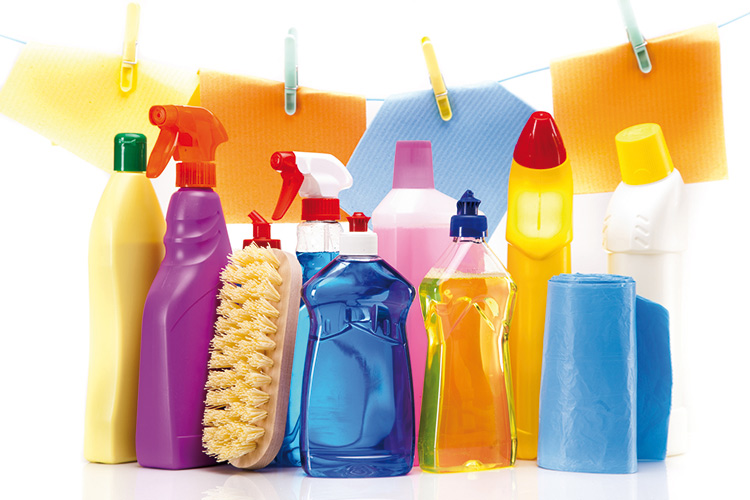Domestic detergency
The products, the performance of the market and the packaging Barbara Iascone

According to the classification used by Federchimica Assocasa, the sector of products for cleaning, maintenance and hygiene of spaces includes detergents, laundry soaps, auxiliary washing products, disinfectants including air sanitizers, waxes, auto care products, air fresheners and cleaning products generally.
The association’s annual report of March 2018 shows a substantial stability for 2017: analysing the data in terms of value, a 0.2% rise on the previous year can be seen.
Examining the single sectors, the best performances are attributable to the disinfestants (+4.8%), favored by the climatic conditions of last year. Washing products register a +0.5%: these are headed by softeners in concentrated form.
Still speaking in terms of value, the detergent products registered a drop of-0.8%; within this sector, the upswing of liquid laundry detergents and dishwashing detergents stand out. This picture changes radically if one looks at the numbers in quantitative terms. According to Istat data, the detergents sector’s total 2017 production saw 7% growth, reaching a total of 3.205.000 t.
Still according to Istat surveys, foreign trade (mainly driven by important international companies active in the sector and present in Italy), closes the year 2017 with a +6.5% for imports and a +6% for exports.
Apparent consumption exceeds 2,500,000 tons (+7.7% compared to 2016).
The difference in trends between volumes and values, which has persisted for some years, is essentially explained by the consolidated habit of saving with promotional offers (things like the “3 for 2” offers) or preferring the packs that can provide a greater number of washes with the same quantity of product.
The detergents industry is moreover making great efforts to, on one hand, satisfy the needs and demands of families, while on the other hand offering innovative, high performance products.
This trend not only influences the products themselves but also the packaging choices in a market that is mature yet still vital in terms of product innovation.

Distribution channels
As for sales channels, still according to Assocasa’s analysis, the only distribution channels seeing any growth are specialist stores (drug specialists), offering a wide assortment of quantities and quality ranges, as well as opportunities for saving. In 2017, this type of store put in a +5.9%.
Discounts registered a modest + 0.3%, while small distribution areas, hyper and supermarkets continue to register a decline.

Packaging types
The detergents sector continues to be dominated by plastic packaging, both rigid and flexible: the only shifts in market share distribution have thus been among different types of plastic packaging.
The choice of packaging material, as in the chemical sector as a whole, is largely a function of the chemical and physical properties of the product to be packaged, but also depends on the communication needs at play for the various commercial brands and product innovations to set themselves apart. The database of Istituto Italiano Imballaggio shows the following packaging mix.
In 2017, plastic packaging made up 93.5% of packaging for household cleaning and maintenance products. This percentage has been constant for the past several years. This percentage includes packaging made of biodegradable plastic, which is constantly growing.
More specifically, we find:
- plastic bottles, which in 2017 made up 68% (-0,3% compared to 2016);
- containers made from flexible polylaminate for converting, which has been growing year after year and which in 2017 reached 22.2% of the total;
- refills for the bottles of detergent, made using biodegradable plastic material (and thus joining the ranks of plastic packaging in this sector), showing constant growth and reaching 1.3% of the total packaging mix in 2017.
The last type of packaging on the list above, in particular, is used for concentrate products that when added to hot water in a plastic bottle are diluted, releasing the right amount to reconstitute the detergent or the original detergent. Another component of plastic packaging are the wrapping films used for bar soaps (1%), as well as tubes (1%).
The remaining 6.5% of packaging for this sector is made up of:
- paperboard boxes used mainly for powder and tab products for dishwashing machines, which in 2017 remained stable at 4%;
- metal spray cans (now exclusively in steel to the detriment of aluminium), at 1.5%;
- rigid laminated containers, which go from 1% in 2016 to 0.5% in 2017;
- the remaining 0.5% is made up of automatic dispensation of loose products, a phenomenon that has not gained as much traction in Italy as in other countries, and which has declined over the years.
In addition to primary packaging, there is secondary transport packaging (corrugated cardboard boxes, heatshrink films and pallets).
Detergency, in the first months of 2018
ISTAT data for the first 5 months of 2018 confirms that the detergent sector started off well, with production up 1.7% compared to the same period of 2016. In the same period, foreign trade features imports are up by 12.5% with exports up by 10.5%. Apparent consumption is expected to fall around -0.2%. According to the assumptions of the Italian Institute of Packaging as regards the packaging mix, the 2017 trends should be confirmed, with flexible and biodegradable plastics respectively showing growth of 22.5% and 1.4%. These increases will again be to the detriment of plastic bottles.
Barbara Iascone
Istituto Italiano Imballaggio

















